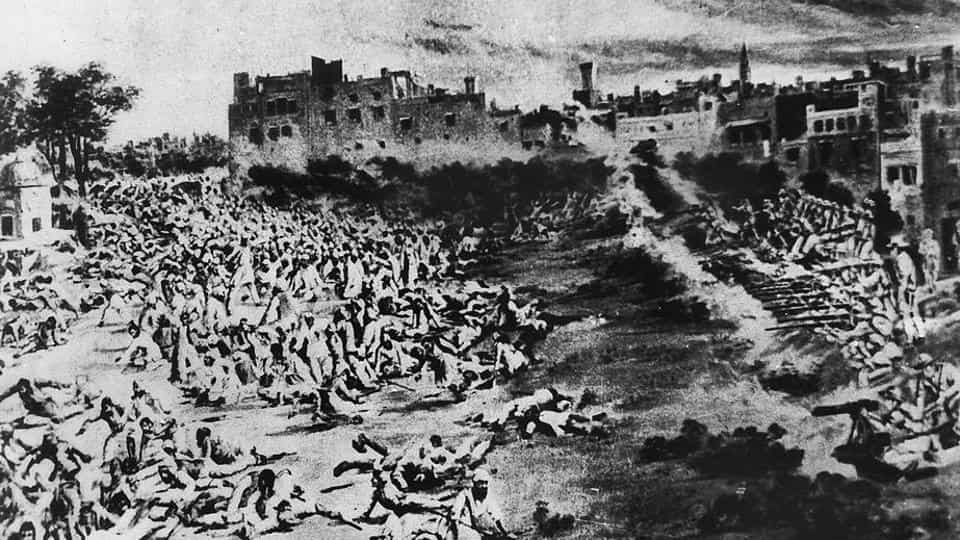The Jallianwala Bagh massacre, also known as the Amritsar massacre, took place on 13 April 1919, when Acting Brigadier-General Reginald Dyer ordered troops of the British Indian Army to fire their rifles into a crowd of unarmed Indian civilians in Jallianwala Bagh, Amritsar, Punjab, killing at least 379 people and injuring over 1,200 other people.
Before the massacre
On 10 April 1919, there was a protest at the residence of Miles Irving, the Deputy Commissioner of Amritsar. The demonstration was to demand the release of two popular leaders of the Indian Independence Movement, Satya Pal, and Saifuddin Kitchlew, who had been earlier arrested by the government and moved to a secret location.
Both were proponents
of the Satyagraha movement led by Gandhi. A military picket shot at the crowd,
killing several protesters and setting off a series of violent events. Riotous crowds
carried out arson attacks on British banks, killed several British people, and
assaulted two British females.
On the evening of 12 April, the leaders of the hartal in Amritsar held a meeting at the Hindu College – Dhab Khatikan. At the meeting, Hans Raj, an aide to Kitchlew, announced a public protest meeting would be held at 18:30 the following day in the Jallianwala Bagh.
It was to be organized
by Muhammad Bashir and chaired by a senior and respected Congress Party leader,
Lal Kanhyalal Bhatia. A series of resolutions protesting against the Rowlatt
Act, the recent actions of the British authorities, and the detention of
Satyapal and Kitchlew was drawn up and approved after which the meeting
adjourned.
Massacre
At 9:00 on the morning of 13 April 1919,
the traditional festival of Baisakhi. Reginald Dyer, the acting military
commander for Amritsar and its environs proceeded through the city with
several city officials, announcing the implementation of a pass system to enter
or leave Amritsar, a curfew beginning at 20:00 that night and a ban on all
processions and public meetings of four or more persons.
By mid-afternoon, thousands of Indians had
gathered in the Jallianwala Bagh (garden) near the Harmandir Sahib in Amritsar.
Many who were present had earlier worshipped at the Golden Temple and were
passing through the Bagh on their way home.
The city police closed the fair at 14:00
that afternoon, resulting in a large number of people drifting into the
Jallianwala Bagh.
An hour after the meeting began as
scheduled at 17:30, Colonel Dyer arrived at the Bagh with a group of ninety
soldiers from the Gurkha Rifles, the 54th Sikhs, and the 59th
Sind Rifles.
Dyer, without warning the crowd to
disperse, blocked the main exits. He stated later that this act “was not to
disperse the meeting but to punish the Indians for disobedience.”[47] Dyer
ordered his troops to begin shooting toward the densest sections of the crowd
in front of the available narrow exits, where panicked crowds were trying to
leave the Bagh.
Apart from the many deaths directly from
the shooting, many people died of crushing in the stampedes at the narrow gates
or by jumping into the solitary well on the compound to escape the shooting.

Image Source: Brown Girl Magazine
Casualties
The number of total casualties is disputed.
The Government of Punjab, criticized by the Hunter Commission for not gathering
accurate figures only offered the same approximate figure of 200.
Aftermath
This event caused many moderate Indians to
abandon their previous loyalty to the British and become nationalists
distrustful of British rule.
Both Secretary of State for War Winston
Churchill and former Prime Minister H. H. Asquith, however, openly condemned
the attack, Churchill referring to it as “unutterably monstrous”, while Asquith
called it “one of the worst, most dreadful, outrages in the whole of our
history”.
Monument and legacy
Trust was founded in 1920 to build a
memorial at the site after a resolution was passed by the Indian National
Congress. In 1923, the trust purchased land for the project. A memorial,
designed by American architect Benjamin Polk, was built on the site and
inaugurated by President of India Rajendra Prasad on 13 April 1961, in the
presence of Jawaharlal Nehru and other leaders. A flame was later added to the
site.
The bullet marks remain on the walls and
adjoining buildings to this day. The well into which many people jumped and
drowned attempting to save themselves from the bullets is also a protected
monument inside the park.
Visit by Queen Elizabeth II
Although Queen Elizabeth II had not made
any comments on the incident during her state visits in 1961 and 1983, she
spoke about the events at a state banquet in India on 13 October 1997.
The Queen’s 1997 statement was not without controversies. During her visit, there were protests in the city of Amritsar, with people waving black flags and chanting the insult “Queen, go back.” Queen Elizabeth and Prince Philip, Duke of Edinburgh merely signed the visitor’s book. The fact that they did not leave any comment, regretting the incident was criticized.
Written By - Violet Priscilla S
Edited By - Anamika Malik










2 Comments
Informative
ReplyDeleteInformative
ReplyDelete